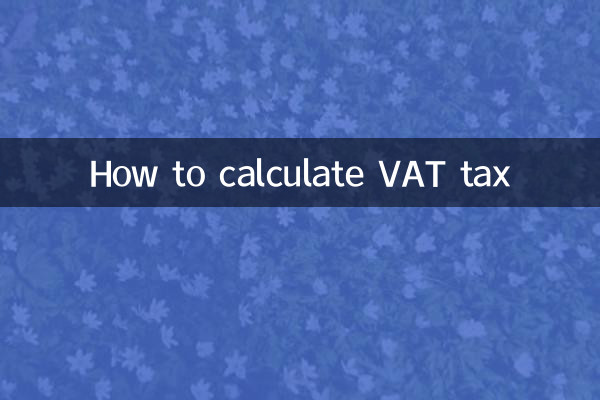How to calculate VAT tax
Value-Added Tax (VAT) is an important tax in my country's tax system and is widely used in the circulation of goods and services. Understanding the calculation method of value-added tax is of great significance to both corporate financial management and personal consumption. This article will provide you with a detailed analysis of the calculation methods of VAT from the basic concepts, calculation methods, tax rates, and actual cases of VAT.
1. Basic concepts of value-added tax

Value-added tax is an indirect tax levied on the added value generated during the circulation of goods or services. Its core lies in "value added", that is, when enterprises or individuals sell goods or provide services, they tax the added value. VAT taxpayers are divided into general taxpayers and small-scale taxpayers, and the calculation methods of the two are different.
2. Calculation method of value-added tax
The calculation methods of value-added tax are mainly divided into general tax calculation methods and simplified tax calculation methods.
1. General tax calculation methods
General taxpayers usually use the general tax calculation method, and the calculation formula is:
Tax payable = Output tax - Input tax
in:
2. Simplified tax calculation method
Small-scale taxpayers usually use the simplified tax calculation method, and the calculation formula is:
Tax payable = sales × collection rate
The tax rate for small-scale taxpayers is generally 3% (5% or other tax rates may apply to some industries).
3. Value-added tax rate
my country's value-added tax rates are divided into multiple levels, as follows:
| Taxpayer type | Tax rate/levy rate | Scope of application |
|---|---|---|
| General taxpayer | 13% | Selling or importing goods and providing processing, repair and repair services |
| General taxpayer | 9% | Agricultural products, transportation, postal service, basic telecommunications, etc. |
| General taxpayer | 6% | Modern service industry, life services, etc. |
| small taxpayer | 3% | most industries |
| small taxpayer | 5% | Real estate sales, leasing, etc. |
4. Value-Added Tax Calculation Example
In order to better understand the calculation of VAT, we illustrate it through two examples:
Example 1: General taxpayer
An enterprise is a general taxpayer and sells a batch of goods with a sales volume of 1 million yuan (excluding tax) and a tax rate of 13%. The purchase of raw materials costs 500,000 yuan (excluding tax), and the tax rate is 13%.
Calculation process:
| project | Amount (10,000 yuan) |
|---|---|
| Output tax | 100 × 13% = 13 |
| Input tax | 50 × 13% = 6.5 |
| tax payable | 13 - 6.5 = 6.5 |
Example 2: Small-scale taxpayers
A certain individual industrial and commercial household is a small-scale taxpayer, with quarterly sales of 300,000 yuan (excluding tax), and the tax rate is 3%.
Calculation process:
| project | Amount (10,000 yuan) |
|---|---|
| tax payable | 30 × 3% = 0.9 |
5. Preferential policies for value-added tax
In order to support small and micro enterprises and specific industries, the state has introduced a series of preferential VAT policies, such as:
6. Summary
The calculation of VAT involves multiple factors such as taxpayer type, tax rate, sales volume and input tax amount. General taxpayers use the method of “output tax minus input tax” to calculate, while small-scale taxpayers calculate directly based on sales volume and collection rate. Mastering the calculation method of value-added tax can not only help companies pay taxes reasonably, but also provide individual consumers with a clearer consumption reference.
Hopefully this article has helped you better understand how your VAT tax is calculated. If in doubt, it is recommended to consult a tax professional or tax authority.

check the details

check the details